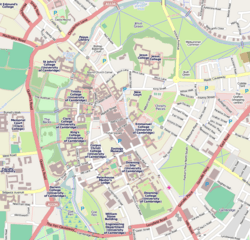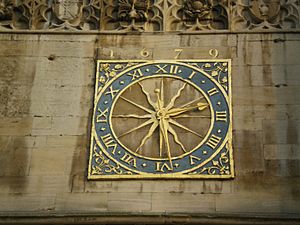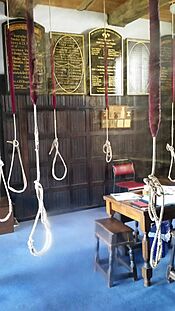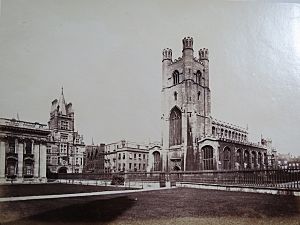Church of St Mary the Great, Cambridge facts for kids
Quick facts for kids Great St Mary's |
|
|---|---|
| Church of St Mary the Great | |
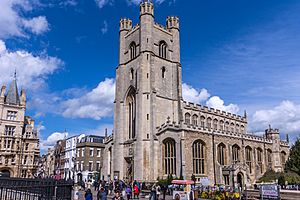
Church of St Mary the Great
|
|
| 52°12′19″N 0°07′06″E / 52.2053°N 0.1182°E | |
| Location | Great St Mary's, The University Church, Senate House Hill, Cambridge, CB2 3PQ |
| Country | England |
| Denomination | Church of England |
| Churchmanship | Liberal Catholic |
| Architecture | |
| Style | Late Perpendicular Gothic |
| Years built | 1478–1519 |
| Specifications | |
| Tower height | 114ft (34.7m) |
| Bells | 13 hung for change ringing (22 total) |
| Tenor bell weight | Tenor bell: 24-1-1 (1232kg) in D |
| Administration | |
| Parish | St. Mary The Great with St. Michael, Cambridge |
| Deanery | Cambridge North |
| Archdeaconry | Cambridge |
| Diocese | Ely |
St Mary the Great is a famous church in Cambridge, England. People often call it Great St Mary's or just GSM. It is a Church of England church and also the official church for the University of Cambridge.
This church is very important to the university. For example, university staff must live within 20 miles of Great St Mary's. Students must live within three miles. The church also holds special university events. It has the University Organ and the University Clock. This clock plays the "Cambridge Quarters" tune. This tune was later used for the famous "Big Ben" clock at the Houses of Parliament in London.
Contents
History of Great St Mary's Church
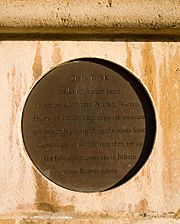
The church was first mentioned in records in 1205. King John appointed a priest named Thomas de Chimeleye then. The church might have been built around 1010. But a big fire destroyed most of it on July 9, 1290. It was rebuilt after the fire.
Before 1352, the church was known as The Church of St Mary the Virgin. After that year, it got its current name. For many years, the king had the right to choose the church's priest. But in 1342, this right went to King's Hall. Later, when King's Hall became part of Trinity College, Trinity College gained this right. They still have it today.
The current church building was constructed between 1478 and 1519. The tower was finished much later, in 1608. Kings Richard III and Henry VII helped pay for most of the building work.
Over the years, the church has been repaired and updated many times. Famous architects like James Essex and George Gilbert Scott worked on it.
Many important thinkers from the English Reformation preached here. One famous person was Erasmus. Martin Bucer, who helped write the Book of Common Prayer, was buried here. Later, his body was removed and burned. But his ashes were later returned to the church. They now rest under a special brass plate.
Great St Mary's Today
Today, Great St Mary's is part of the Liberal Catholic tradition. This means it is a welcoming and inclusive church.
The Bells of Great St Mary's
At first, the church bells were in a wooden building in the churchyard. In 1515, the bells were moved into the church tower. In 1722, new bells were installed. Two years later, in 1724, a group called the Society of Cambridge Youths was formed. Their job was to ring the bells. This group is thought to be the oldest bell-ringing society in Britain. It is also the second oldest in the world with a continuous history of ringing bells.
In 2009, the old bells were replaced. New bells were made by Taylors Eayre and Smith Ltd. This was possible because of a generous gift from Dr Martin C Faulkes. The new set has 13 bells. Some of the original bells were kept. They are still used to play the famous Cambridge Chimes.
The Organs of Great St Mary's
Great St Mary's is special because it has two separate pipe organs. One is called the 'Parish Organ'. It is in the Chancel and is used for regular church services. The other is the 'University Organ'. It is in the West Gallery. The University owns and takes care of this organ. It is played during university services.
The University Organ was first bought in 1698. It was built by a famous organ maker known as 'Father' Bernard Smith. Over the years, it was added to and improved. In 1870, it had a major rebuild. It was restored again in 1995. This organ is a very important historical instrument. It also has many parts from Father Smith's original work. The Parish Organ was built more recently, in 1991.
Church Design and Features
The church is built in the Late Perpendicular style. This is a type of English Gothic architecture. The beautiful stained glass windows were added between 1867 and 1869. They were made by Hardman.
The church has special galleries. These were added in 1735. They helped fit the large crowds who came for important events. This included the University Sermon, which everyone had to attend. The church also has one of the few movable pulpits in England. The font, where baptisms take place, is from 1632. Behind the main altar, there is a sculpture of Christ. This sculpture was finished in 1960. It was created by Alan Durst.
Notable Burials and Funerals
Great St Mary's has been the site of funerals for some well-known people.
- Martin Bucer (1491–1551), a Protestant reformer.
- Stephen Hawking (1942–2018), a famous theoretical physicist. His funeral was held here in 2018.
- Jack Merritt (1994–2019), a prison educator and mentor. His funeral was held here in 2019.


